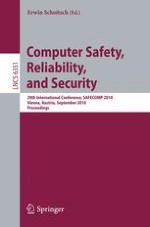Computers and microprocessors are indispensable in modern technical systems, their deployment spanning the domains automotive, railway, aerospace, and transportation, security, energy supply, telecommunication, critical infrastructures and process ind- tries. They perform tasks that a few decades ago were very difficult if not impossible. As they perform these tasks with increasing efficiency, more and more tasks are shifted from hardware to software, which means that the dependability of computer systems becomes crucial for the safety, security and reliability of technical systems. With the so-called “embedded systems” (becoming more and more intelligent, networked and co-operating with each other, with humans and the environment) computers have invaded all aspects of daily life. New paradigms have arisen, like ubiquitous computing, systems-of-systems, energy and resource awareness, enormous complexity issues and the like, requiring a more holistic systems view as well. th So, after 31 years of SAFECOMP, the emphasis of the 29 event is on critical - bedded systems, which are almost omnipresent. Their impact on our lives, risks and challenges are often not well understood (underestimated or exaggerated). The p- mary issue is to cope with complexity, new failure modes and resource management, due to shrinking feature size, multi-core systems and management of multiple variants, while maintaining dependability properties and robustness.
